For millions of Americans the end of World War II brought a time of new opportunity and unprecedented prosperity. Housing developers reveled in the need for new housing and jumped at the chance to build acres and acres of tract homes - modest, homogenous little "crackerboxes" with basic amenities - and bought up land in the areas surrounding the Twin Cities and other communities in Minnesota. Families in search of the American Dream migrated in droves from the cities to the rapidly expanding suburbs in search of a better life: a home of their own, a better place to raise their families, and room to breathe.
Richfield, a first-ring suburb just south of Minneapolis, was the fastest growing of all Twin Cities suburbs, with a 363% increase in population from 1940 to 1950. Like the new tract homes, residents in the 1940s and 1950s were pretty homogenous. Almost exclusively white, the population consisted of mostly young families with children, with primary occupations in construction, manufacturing and trade. By 1954 Richfield had become the fifth largest town in Minnesota with a population of 31,756. The metropolitan suburbs of St. Louis Park, Bloomington, Roseville, and West St. Paul also experienced very rapid expansion during the post-war building boom.
As the suburbs grew, demand for village services, better roads, and other amenities became greater. Schools were built in record numbers in anticipation of the influx of students of the "baby boom" generation, as well as churches and synagogues, medical facilities, shopping centers, swimming pools, sports facilites, golf courses, parks, and other conveniences that would contribute to the quality of suburban life. Neighbors felt a real sense of community, often socializing with one another's families and sharing responsibility for watching neighborhood children.
Such rapid growth brought with it unique growing pains. Post-war suburbanites used to city life found themselves temporarily living next door to farms. They lived and commuted to work on unpaved roads, and endured the construction of the freeway system. Residents tooks sides in debates over village water and sewer construction issues.
The national trend toward consumerism was reflected in the number of neighborhood shopping centers that were built in the 1950s, which provided convenient places for suburban families to shop. Most centers boasted a Red Owl or National Tea grocery store and a department store as anchors, with a hardware store, drugstore, and other practical shops in between. When Southdale Center, the first fully enclosed shopping center in the United States, opened in Edina in 1956 with its 72 stores, it ushered in a new trend in convenient, one-stop suburban shopping.
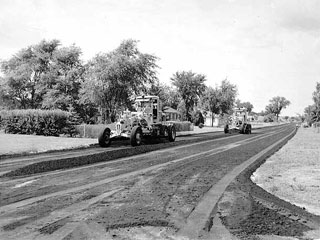
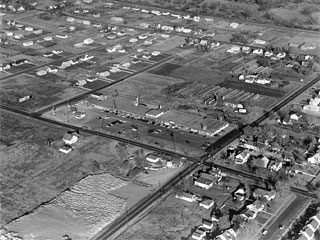
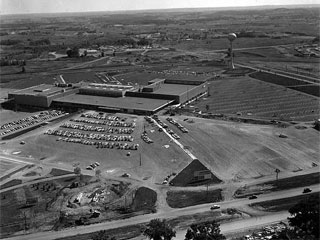
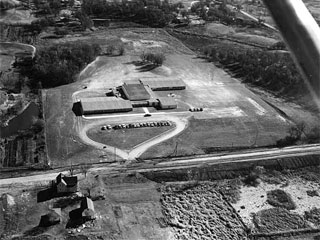
The American Dream
During World War II building materials were diverted to the war effort and new home construction slowed. At the same time, thousands of young men who had left home at 18 had grown into men, ready for a home and family of their own. These factors combined to create a nationwide housing crisis. G.I.s returning to Minnesota, many with young families, found it very difficult to find suitable housing.
Temporary housing in the form of military surplus Quonset huts, trailers, and makeshift structures was created to provide shelter while homes could be built. Developers very quickly put up acres of affordable tract homes on small lots in the suburbs around the cities, and in smaller communities around the state. By 1947 Richfield and St. Louis Park, two of the fastest growing of the Twin Cities suburbs during the post-war years, saw an average of nearly 100 homes built each month. These look-alike homes followed basic plans and were most often single-story, with one or two bedrooms, a living room, dining room, kitchen, and bathroom. Former servicemen and women could obtain a favorable loan through the G.I. Bill of Rights that made it possible for them to purchase a home of their own.
In search of more "open space," Marian Maxson and her husband built a new home in Richfield before the war, and over the years watched the neighborhood around them turn from farmland to houses. Martha Doughty and her family found a home in an established neighborhood in St. Louis Park in 1952, and found new friends and good neighbors. Emily Day and her husband purchased a pre-war home on Clinton Avenue in Richfield in 1949 - the only house they could find in that village when the farm they had been renting in Bloomington was sold out from under them.
Whatever the reason for moving to the suburbs, each family found one thing in common: their own piece of the American Dream.

Life's Better Here
For many Twin Citians, post-war life in the suburbs meant a better life. They migrated to places like Richfield, Roseville, and St. Louis Park in search of an affordable first home of their own or a larger house to accommodate a growing family, a quieter neighborhood, a safer place to raise their children.
Homes in the suburbs were newer and more modern than many located within the city limits. Newly built suburban neighborhoods attracted many young families with common backgrounds and lifestyles, offering both adults and children new friends and many opportunities for social interaction. Men joined newly organized chapters of fraternal organizations, golf and bowling leagues. Stay-at-home moms found satisfaction through volunteer work, bridge clubs, and PTA meetings. Children joined scout troops and little league teams. Because many residents still held jobs in the cities, suburbs gained the reputation of "bedroom communities" as large numbers of commuters took to the newly developed highway system to get to work each day, and to return home each evening.
As the suburbs grew, so did the variety of amenities for their residents. Many new schools were built to accommodate the "baby boom" generation as they reached school age in the 1950s and early 1960s. Churches and synagogues were built or expanded. Nearby shopping centers provided convenient, one-stop shopping for all the suburban heart could desire. Neighborhood parks and local swimming pools offered family recreation. Bowling alleys, movie theaters, sports facilities, and other entertainment venues became popular places for residents to spend leisure time, when they weren't relaxing in lawn chairs near the barbeque in the backyard.
Life in the suburbs in the post-war boom was the best of all worlds, and long-time residents still insist, "Life's better here!"

Growing Pains
The rapid growth of the suburbs during the years following World War II brought many challenges to the residents of those communities.
Housing construction outpaced many a village government's ability to provide necessary services like water and sewer lines, which meant the digging of private wells and installation of septic tanks and drain fields. Residents locked horns in heated debates about the pros and cons of their village hooking up with Minneapolis or St. Paul water and sewer systems. Streets running past homes in the new neighborhoods remained unpaved as road crews struggled to keep up with the demand. The influx of large numbers of young families with "baby boom" children meant that more schools needed to be built and more teachers hired.
The necessity of getting suburban residents to their jobs in the cities brought up transportation issues. Public transportation in the Twin Cities was undergoing a metamorphasis from an old but efficient streetcar system to new buses with fewer routes to outlying areas. With the passage of the Federal-Aid Highway Act of 1956, federal dollars became available to aid in the construction of the freeway system in the Twin Cities, which offered daily commuters a more efficient way into the cities by automobile.
The growth of the freeway system brought it's own problems. Some suburbs, like Richfield, were boxed in by major highways, which created a sense of isolation from neighboring communities. Most families only had one vehicle, which often meant that the breadwinner drove, while the rest of the family walked or bicycled wherever they needed to go, or stayed at home.
Over the years Richfield had another unique challenge that other suburbs did not: airport expansion. As Wold-Chamberlain Field became Minneapolis-St. Paul International Airport, it began to appropriate adjoining land, taking houses, a school, and other buildings in its path. Some residents saw the positive side of a larger airport, citing more jobs for local residents and travel convenience in the airport's close proximity. Others saw the negative side: noise, congested roads, and fewer homes.
Regardless of these growing pains, Twin Cities suburbs thrived as residents rose to every challenge.
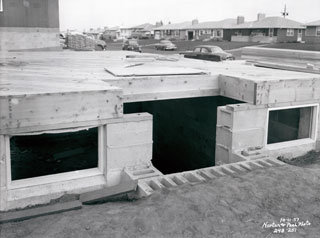
A Generation Of Consumers
After fifteen years of deprivation caused by the Great Depression and the shortages of World War II, Americans were ready for the unprecedented prosperity they would enjoy in the 1950s. Jobs were plentiful and the unemployment rate, which had been nearly 25% during the Depression, dropped to a manageable 5.3% by 1950 and remained fairly steady through the decade. The minimum wage rose from 30 cents an hour in 1940 to 75 cents an hour in 1950. Most people found they had more expendable income and were eager to spend it on newly available goods for their homes and families.
The availability of materials that had been in short supply during the war helped American manufacturers revert back to civilian production. For the first time in several years, Minnesotans could purchase a new car or piece of farm machinery, as well as washing machines, refrigerators and freezers, and other convenience items. Stores showcased the latest in gas and electric appliances as customers lined up to purchase them, and signed up for seminars to learn how to use them. Luxury items like television sets became more affordable and began to appear in the average family's living room.
Riding the wave of this new prosperity and following the migration of people from urban to suburban locations, developers began to build neighborhood shopping centers to cater to the needs of people living away from city centers. Often within walking distance of new housing developments, the resulting "strip malls" offered a convenient place where a family could purchase food, clothing and personal items, hardware, and other neccesities without having to make the trip downtown.
Post-war consumerism also sparked the growth of a new breed of mega-shopping center. Southdale, the first fully-enclosed, atmosphere-controlled mall sprang up in the fields of Edina, a Minneapolis suburb. Built by the Dayton Development Company on a tract of 84 acres at a cost of $20 million, it's 72 stores included the first suburban Dayton's Department Store, a Red Owl grocery store, a hardware store, a Woolworth's, and a host of other shops. The developers envisioned Southdale as a centerpiece for further retail and residential development in the area, and it set a pattern for future retail development; it's success encouraged the construction of sister centers Brookdale (1962), Rosedale (1969), and Ridgedale (1974), all of which would become successful suburban retail districts.
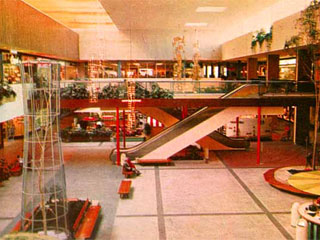
Citations:
 Document: Highlights of Richfield in 1954: Richfield Is Fifth Largest.
Document: Highlights of Richfield in 1954: Richfield Is Fifth Largest.- Johnson, Frederick L., Richfield: Minnesota's oldest suburb. Richfield, MN: Richfield Historical Society, 2008.
- Saylor, Thomas, Interviewer, Richfield Oral History Project, Minnesota Historical Society Oral History Collection, 2007-2008.
- Poseley, Judy, The Park: a history of the city of St. Louis Park. Saint Louis Park[?], Minnesota, 1976.
- Donaldson, Scott, The making of a suburb: an intellectual history of Bloomington, Minnesota. Bllomington, MN: Bloomington Historical Society, 1964.
- Bakeman, Mary and Patricia Johnson, Interviewers, Remembering Roseville Oral History Project. Minnesota Historical Society Oral History Collection, 1998.
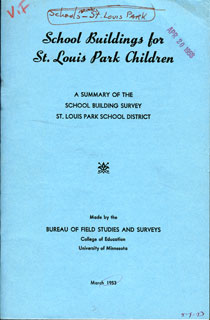 Document: School Buildings for St. Louis Park Children, 1953.
Document: School Buildings for St. Louis Park Children, 1953. Photo: Construction of Holy Family Catholic Church, St. Louis Park, 1951.
Photo: Construction of Holy Family Catholic Church, St. Louis Park, 1951.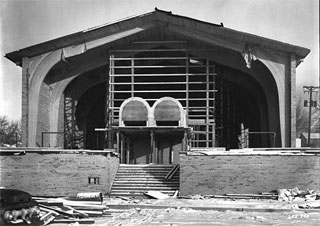 Photo: Construction of B'Nai Emet Synagogue, Ottawa Avenue and Highway 7, St. Louis Park, 1958.
Photo: Construction of B'Nai Emet Synagogue, Ottawa Avenue and Highway 7, St. Louis Park, 1958.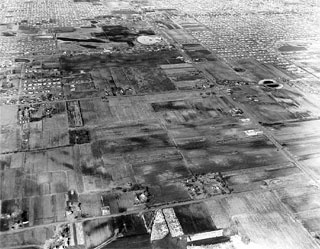 Photo: Aerial view of Bloomington - Richfield showing Seventy-eighth and Cedar Avenue (stadium site), 1955.
Photo: Aerial view of Bloomington - Richfield showing Seventy-eighth and Cedar Avenue (stadium site), 1955.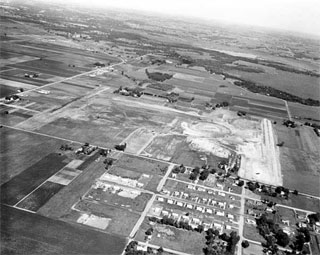 Photo: Aerial of Metropolitan Stadium excavation, Bloomington, 1955.
Photo: Aerial of Metropolitan Stadium excavation, Bloomington, 1955.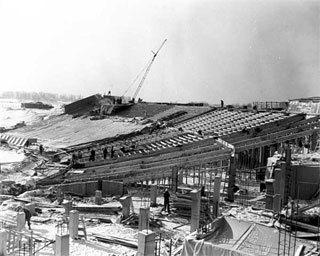 Photo: Met Stadium construction, Bloomington, 1956.
Photo: Met Stadium construction, Bloomington, 1956.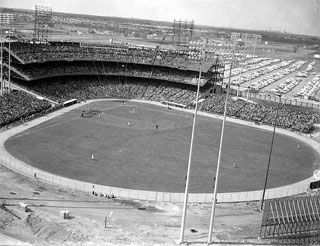 Photo: Dedication of Metropolitan Stadium, Bloomington, April 24, 1956.
Photo: Dedication of Metropolitan Stadium, Bloomington, April 24, 1956. Photo: Metropolitan Stadium, Bloomington, Greater Minneapolis Chamber of Commerce postcard, 1960.
Photo: Metropolitan Stadium, Bloomington, Greater Minneapolis Chamber of Commerce postcard, 1960.- Jackson, Kenneth T., Crabgrass frontier: the suburbanization of the United States. New York: Oxford University Press, 1985.
- Southdale Mall. Minnesota Historical Society: Library: History Topics, 2008.
 Photo: Sprinkling system at a golf course; golfers teeing off at right, Minneapolis Golf Club, St. Louis Park, 1954.
Photo: Sprinkling system at a golf course; golfers teeing off at right, Minneapolis Golf Club, St. Louis Park, 1954.
- Johnson, Frederick L., Richfield, Minnesota's Oldest Suburb. Richfield Historical Society, 2008.
 Photo: Post war housing, 1946.
Photo: Post war housing, 1946.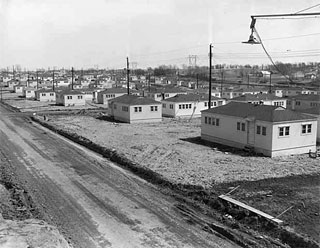 Photo: Temporary housing, Fillmore Street Northeast, Minneapolis, 1948.
Photo: Temporary housing, Fillmore Street Northeast, Minneapolis, 1948.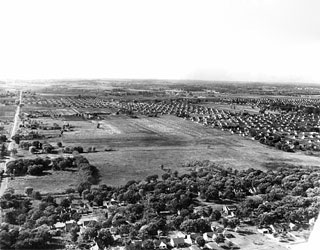 Photo: Aerial views of Richfield near the vicinity of Wood Lake and Penn Avenue, 1952.
Photo: Aerial views of Richfield near the vicinity of Wood Lake and Penn Avenue, 1952.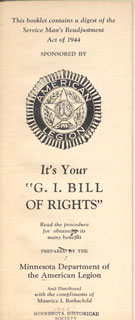 Document: It’s your "G.I. Bill of Rights".
Document: It’s your "G.I. Bill of Rights".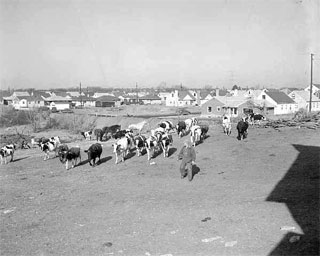 Photo: View of housing development near John Tierney farm, Sixty Second Street and Penn Avenue South, Richfield, 1954.
Photo: View of housing development near John Tierney farm, Sixty Second Street and Penn Avenue South, Richfield, 1954.
 Photo: Kitchen in residence at 4816 Dunberry Lane, Edina, 1957.
Photo: Kitchen in residence at 4816 Dunberry Lane, Edina, 1957.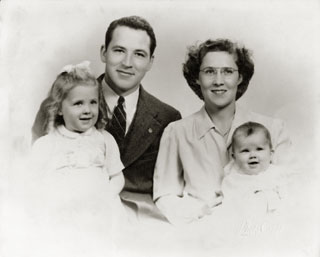 Photo: The Maxson family of Richfield, about 1946.
Photo: The Maxson family of Richfield, about 1946. Photo: Highland Park Elementary School Parent-Teacher Association fundraiser, 1956-1957.
Photo: Highland Park Elementary School Parent-Teacher Association fundraiser, 1956-1957.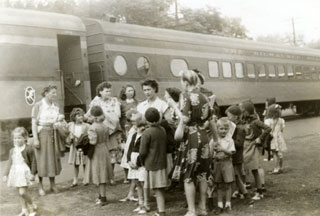 Photo: A troop of Brownie Scouts from Richfield prepares to board a train for an outing, ca. late 1940s.
Photo: A troop of Brownie Scouts from Richfield prepares to board a train for an outing, ca. late 1940s.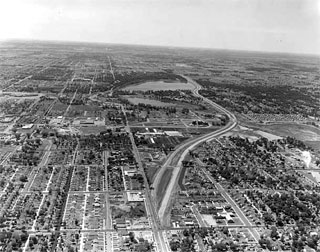 Photo: Aerial, Minneapolis looking south toward Lyndale Avenue and Highway 35W (65), 1955.
Photo: Aerial, Minneapolis looking south toward Lyndale Avenue and Highway 35W (65), 1955. Photo: Construction of Richfield Junior High School, 1959.
Photo: Construction of Richfield Junior High School, 1959.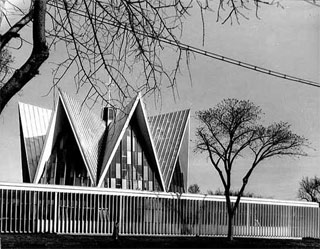 Photo: St. Peter's Lutheran Church, 5421 France Avenue, Edina, 1959.
Photo: St. Peter's Lutheran Church, 5421 France Avenue, Edina, 1959.- The history of St. Peter's Lutheran Church. St. Peter's Luteran Church and School web site, 2008.
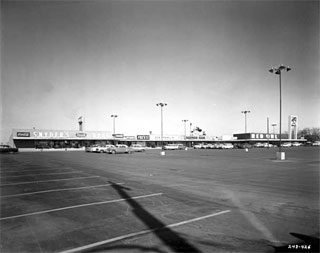 Photo: Walsh's Shopping Center, 9833 Lyndale Avenue South, Bloomington, 1957.
Photo: Walsh's Shopping Center, 9833 Lyndale Avenue South, Bloomington, 1957.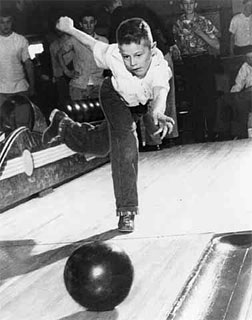 Photo: Young boy bowling, 1955.
Photo: Young boy bowling, 1955. Photo: Man cooking on an outdoor grill, 1955.
Photo: Man cooking on an outdoor grill, 1955.
- Guyer, Bernard, MD, MPH; Mary Anne Freedman., MA; Donna M. Strobino, PhD; Edward J. Sondik, PhD; Annual Summary of Vital Statistics: Trends in the Health of Americans During the 20th Century. Pediatrics, vol. 106 no. 6, December 2000, pp. 1307-1317.
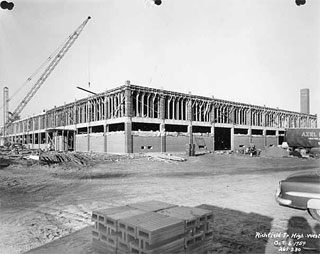 Photo: Construction of Richfield Junior High School, 1959.
Photo: Construction of Richfield Junior High School, 1959. Document: School Today in Richfield, 1962. League of Women Voters Report.
Document: School Today in Richfield, 1962. League of Women Voters Report. Document: School Buildings for St. Louis Park Children, 1953.
Document: School Buildings for St. Louis Park Children, 1953.- Andersen, Jeanne, Schools Cheatsheet. St. Louis Park Historical Society, 2008.
 Photo: Streetcar track removal on East Fifth Street at intersection of Cedar, St. Paul, 1954.
Photo: Streetcar track removal on East Fifth Street at intersection of Cedar, St. Paul, 1954.- Anderson, Matthew, Podcast: Streetcars in St. Paul and Minneapolis. Minnesota Historical Society: Collections Up Close Podcast and Blog, 2008.
- Text: National Interstate and Defense Highways Act (1956).
- National Interstate and Defense Highways Act (1956). www.ourdocuments.gov, 2008.
- Cavanaugh, Patricia, Politics and Freeways: Building the Twin Cities Interstate System. University of Minnesota Center for Transportation Studies, Center for Urban and Regional Affairs (CURA), c. University of Minnesota Board of Regents, 2006.
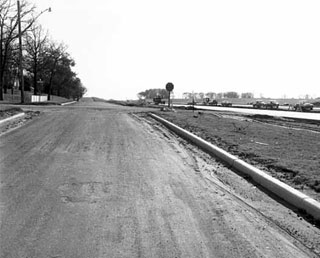 Photo: Construction of four lane road (Interstate 35) at Humboldt Avenue South and Seventy Third West, Richfield, 1958.
Photo: Construction of four lane road (Interstate 35) at Humboldt Avenue South and Seventy Third West, Richfield, 1958.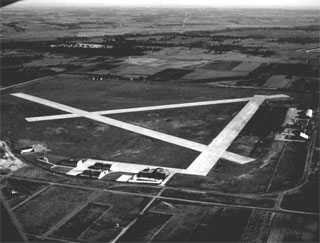 Photo: Photographs showing the growth of Wold-Chamberlain Field, 1940-1956.
Photo: Photographs showing the growth of Wold-Chamberlain Field, 1940-1956.- Waters, Alvin W., The Twin City Motor Speedway. Minnesota History Magazine, vol. 60, no. 8, Winter 2007/08, p. 304-311. St. Paul: Minnesota Historical Society.
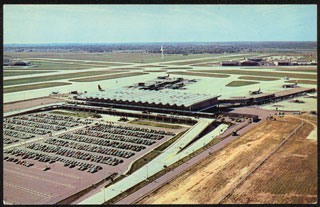 Photo: Views of Minneapolis-St. Paul International Airport, 1965-1975.
Photo: Views of Minneapolis-St. Paul International Airport, 1965-1975.
- Text: Minimum Wage Rates, 1938-1998.
- Federal Minimum Wage Rates, 1938-1998. U.S. Census 2000 on www.Allcountries.org, 2008.
 Photo: Window display of electric home laundry equipment, Minneapolis, 1949.
Photo: Window display of electric home laundry equipment, Minneapolis, 1949.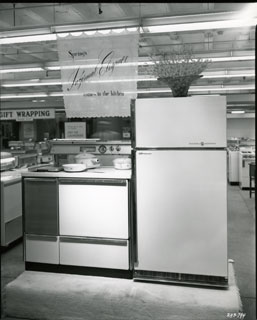 Photo: General Electric kitchen appliances on Dayton's sales floor, 1957.
Photo: General Electric kitchen appliances on Dayton's sales floor, 1957. Photo: Minneapolis Gas Company store in Southdale Center, Edina, 1956.
Photo: Minneapolis Gas Company store in Southdale Center, Edina, 1956.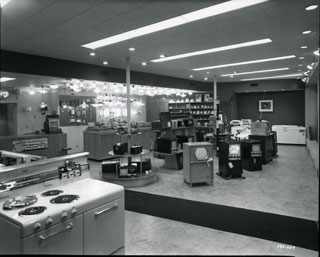 Photo: Household appliances on display, Suburban Electric Company, 1950.
Photo: Household appliances on display, Suburban Electric Company, 1950. Map: Minneapolis Gas Company household appliance demonstration, 1957.
Map: Minneapolis Gas Company household appliance demonstration, 1957.- Meier, Peg, The shopping center that spawned a community. Minneapolis: MSP Communications; Minneapolis-St. Paul Magazine, Vol. 9, no. 8, August 1981, p. 66-69, 130-131.
 Photo: Television, Leonard and Wanda Lindbergh residence, Minneapolis, 1950.
Photo: Television, Leonard and Wanda Lindbergh residence, Minneapolis, 1950.- Television. Microsoft® Encarta® Online Encylopedia, 2008.
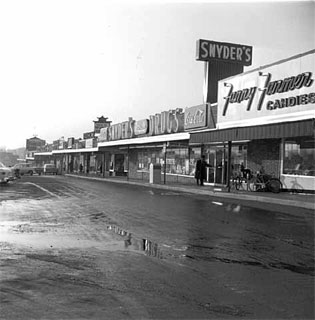 Photo: Roseville Shopping Center, North Lexington, Roseville, 1960.
Photo: Roseville Shopping Center, North Lexington, Roseville, 1960.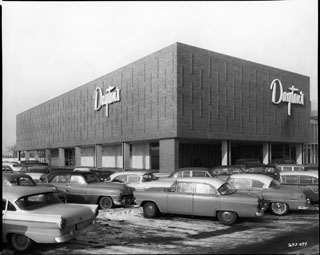 Photo: Dayton's at Southdale Center, Edina, 1957.
Photo: Dayton's at Southdale Center, Edina, 1957.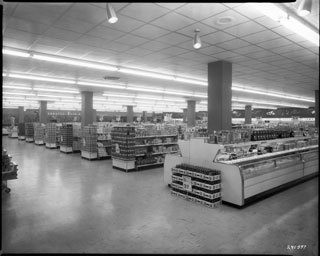 Photo: Interior, Red Owl Store at Southdale Center, Edina, 1956.
Photo: Interior, Red Owl Store at Southdale Center, Edina, 1956.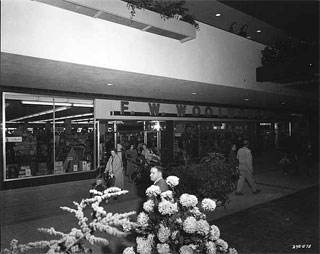 Photo: F. W. Woolworth store, Southdale, Edina, 1956.
Photo: F. W. Woolworth store, Southdale, Edina, 1956. Photo: Interior of Brookdale Shopping Center, Brooklyn Center, 1967.
Photo: Interior of Brookdale Shopping Center, Brooklyn Center, 1967. Photo: Rosedale Center, near Highway 36 and Snelling, Roseville, 1972.
Photo: Rosedale Center, near Highway 36 and Snelling, Roseville, 1972.


